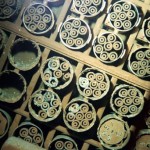
Last week a British treasure-hunter, Ian Snook, barely escaped a rather unpleasant end when his metal detector began clicking madly on a beach in Dorset, England. Answering the siren call of potential loot, Snook began digging furiously, only to find a battered metal sign. It read “Precaution–bombs fire instantly on breaking in air. Stringent precautions must be taken to avoid cracking during handling–the caps must never be removed.”
Below lay 24 World-War-Two glass bottles filled with deadly phosphorus and benzene. The British Army had buried these grenade-like weapons 70 odd years ago to dispose of any Nazi landing craft.
The faded sign, with its words of clear warning, prevented Snook from accidentally blowing himself to smithereens. And that’s good: while I am not particularly fond of treasure hunters, I wouldn’t wish this fate on anyone. But this little news item got me thinking. How on earth are we going to warn future generations of archaeologists and other curious types from digging in similarly toxic sites 1000 years from now, or even 10,000 years from now?
We can’t, after all, count on posting simple metal signs written in English. Languages evolve relatively rapidly, rendering millennia-old texts pretty much unintelligible to all but a few scholars. So how do we keep future generations far, far away from places such as the Hanford Nuclear Site in Washington State, one of the most radioactively and chemically contaminated places on Earth.

It turns out that I’m not the only one worried about it. The U.S. Department of Energy’s Office of Legacy Management (and if ever there was an Orwellian name for a government department, this is it) is currently trying to produce a clear, unequivocal, visual warning that will send future generations fleeing from polluted sites.
A few years ago, reported Grist, James Wise, a psychologist at Washington State University, Tri-Cities, and one of his students, Stuart Davis, attempted to lend a helping hand. The two researchers surveyed 75 residents of southern Washington to determine what symbols people found the most inherently alarming. What Wise and Davis discovered was that symbols resembling sharp canine teeth, bolts of lighting, and triangles all make us very uneasy. “As forms get sharper and get more edges, people dislike them,” Wise told Grist.
The Hanford Nuclear Site is supposed to be buried forever in 2012. I sure hope the folks in the Office of Legacy Management can manage to come up with a warning device that is considerably clearer than the name of their department.
Upper photo courtesy of Joe Mabel.
Lower photo courtesy of U.S. Department of Energy.
I’d have thought the good old grinning skull and crossbones was a fairly strong contendor for ‘danger of death’, given its long history of use as a memento mori. Of course that’s a contemporary reaction schooled by my cultural upbringing; but it does have pedigree. Plundering history for warning symbols, in any case, would seem better practice than this:
Great! Now we know, to a risibly tiny degree of significance, what alarms twenty-first-century Washingtonians. Compare also the story recently that noted with alarm the vast amount of psychological work that generalises for the whole human race from American middle-class college students.
Hi Jonathan:
You raise several excellent points here. One of the Washington State University psychologists did indeed consider the skull and crossbones symbol, but ultimately discarded it. He worried that some future treasure hunter might mistakenly see the skull and crossbones as marking a spot where pirates buried their loot.
I agree that the described survey is very limited in scale and composition. But it is just part of a much larger cross-cultural project. The psychologists also plan to survey people of other nationalities and cultures. I clearly should have mentioned that in my post. Mea culpa!